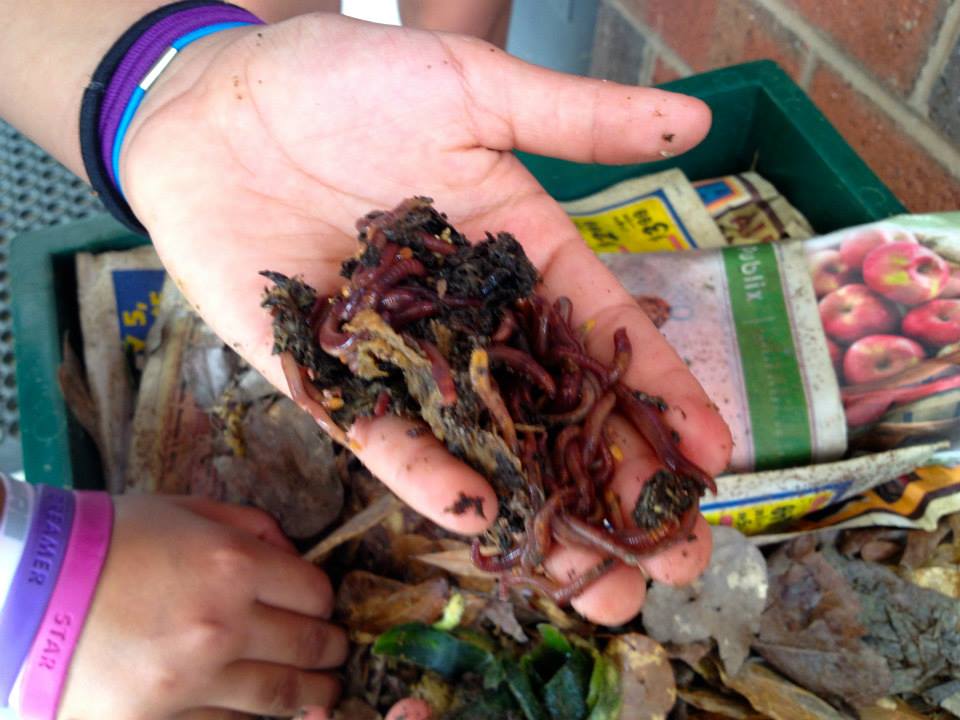
Richland County educators are invited to borrow the Richland Soil and Water Conservation District's (SWCD's) vermicomposting kit to set up small, indoor, earthworm -powered compost bins for classrooms and youth groups. The supplies may be borrowed for a one-week period, and the borrower is responsible for the pickup and return of the kit.
The worm bin activity can be used to teach about soil health, decomposition, earthworm habitat and life cycles, waste reduction, and the benefits of composting. Taking part in this lesson means you will be adopting and caring for a new class pet! The materials provided will be enough for up to 4 classes of 25 students each.
The vermicomposting kit includes a large worm bin demonstration box (property of the Richland SWCD) which holds many worms, worm eggs, and amazing soil produced by the worms. You may even find some pieces of damp newspaper or browned banana peels! Also included is a large stack of newspaper, 2 containers of sandy soil (half container per class), 2 empty containers for water, a spade, a sample bag of compost, models of worms in various stages of the reproduction cycle, and up to 4 empty bins. You will keep one empty covered bin with holes drilled to house your worms per class. You are permitted to take 1 scoop of soil, worms and worm eggs from the SWCD’s bin per class to place in your classroom’s bin. A selection of children's books about vermicomposting will also be provided.
Contact the Richland SWCD at RichlandSWCD@gmail.com for more information. Request the kit by filling out this form. Evaluate this educational equipment rental using this form.
How to care for your new class pets:
General tips and safety
- Worms do not enjoy light and will become paralyzed if left in natural or unnatural light for too long.Please take care of our worms by limiting your peaking at these interesting creatures!Be sure to quickly cover worms back up with newspaper or soil.Leave the lid on the bin as often as possible.
- Don’t leave too much water behind on the newspaper pieces.Be sure to squeeze out thoroughly as to not drown our worm friends!
- Wash your hands after touching anything in the worm bin, including worms and SOIL.This soil is actually worm poop (called castings) so be sure to keep all hands away from the face before washing.
Making the food and bedding:
Preparation before students arrive:
- Unfold sheets of newspaper and make a big stack.You can place 2 on each student’s seat or wait to distribute as they walk in.
- Place 2 of the white bins at each table or group of students.
- Fill up 2 empty containers with water
- Set up sample bag of compost, worm reproduction models, and the demonstration bin where everyone can see.Remember- keep the lid on the demonstration bin as much as possible.Students can be brought up in small groups to peak under the newspaper to find some worms.Cover them back up quickly!
When students arrive:
- (Teacher) After short reading and/or discussion on soil health, decomposition, and/or composting, begin hands-on activity.
- First, students will rip up newspaper into small strips (they can be long but not thick!).It helps to fold the newspaper back up on its creases and tear from the closed end of the newspaper down.
- When complete, instruct students to place their group’s newspaper in one of the white bins.This will be the WET bin.The second (currently empty) bin will act as the DRY bin.
- (Teacher) Pour containers of water (half to 1) into each group’s wet bin.
- Instruct students to mush the newspaper into the water, getting it completely soaked.
- Worms like a moist home, but not too moist or else they will drown!This is why it is so important to instruct students to take small handfuls of newspaper and squeeze it as hard as you can over the wet bin.They should not drip and should feel similar to a damp washcloth.
- When newspaper becomes damp, instruct students to place it in the dry bin.
- Next, instruct the students to fluff up the newspaper.Pull the pieces apart.
- (Teacher) Finally, Pour containers of sandy soil (use half a container per CLASS) into each group’s dry bin.
- Instruct students to mix sandy soil in with the newspaper.Worms don’t have teeth and need the roughness of the soil to aid in their digestion!
- (Teacher) Pour each group’s dry bin into the (currently empty) large classroom bin.This will be your worms’ new home!
- (Teacher) Use the shovel to take one scoop of soil (that includes worms and worm eggs) to place into classroom bin.
- (Teacher) Quickly cover up the worms with newspaper and put the lid on.
Future care:
- These worms will act as your new class pets and we hope you will take care of them well!
- Give worms 1-2 scraps of compostable food per week from your lunch.Feed your worms and reduce waste!
- Replenish newspaper (activity above) as necessary.
- Remember to use the healthy soil your worms produce to grow some plants!
Contact the Richland SWCD at RichlandSWCD@gmail.com for more information. Request the Worm Bin Making Kit by filling out this form. Evaluate this educational equipment rental using this form.
# # #
Conservation Districts are political subdivisions of state government under the local direction of five-member Boards of Commissioners. In South Carolina, Conservation District boundaries conform to County boundaries. The Richland Soil and Water Conservation District promotes the wise use of natural resources for the benefit of the citizens of Richland County.
Contact
Richland Soil and Water Conservation District
2020 Hampton Street, Room 3063A
Columbia, SC 29204
Phone (803) 576-2080
Fax (803) 576-2088
E-mail soilandwater@rcgov.us
Facebook www.facebook.com/rswcd